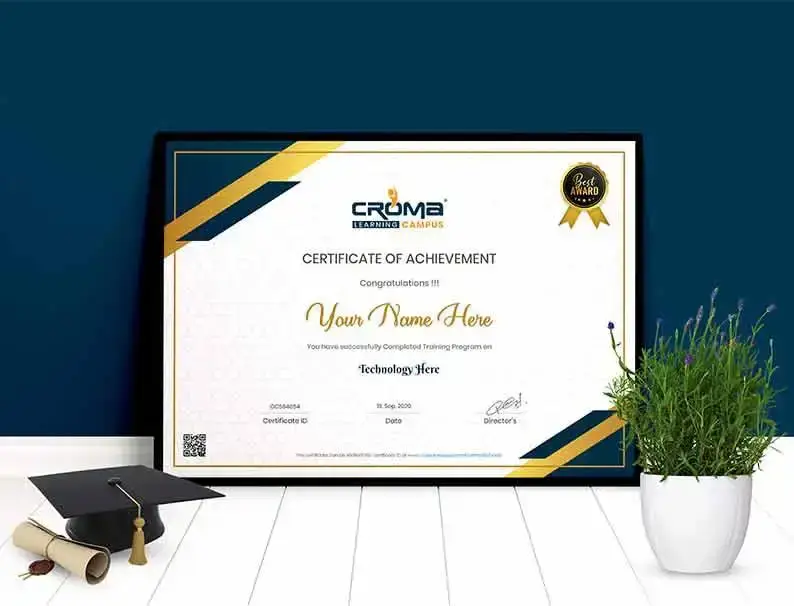Course Design By
Nasscom & Wipro
Introduction
Basics
More Tags in Html
HTML5
More CSS properties
Form Elements
CSS 3
JavaScript
JavaScript Supported Data structures
Advanced JavaScript
Bootstrap 5
jQuery Framework
jQuery Traversing Methods
Events using jQuery
AJAX
jQuery Templating
React-JS
React Basics
Using fetch & promises & async await in ReactJs to get API data.
Fragments in ReactJs
Pure components in ReactJs
memo in functional components
Refs in ReactJs
Refs in class components
Portals in ReactJs
Higher Order functions
React Router
In details of Switch, Router, path, Link, useParams, useRouteMatch
Router paramters
Router nesting
Transitions with Router
Router config
Router Redirecting
Developing router practical application
Redux in React
Creating store with redux
Data flow in redux
Redux actions & reduces
Developing redux practical application
Advanced context API
React.createContext
Context.Provider
Class.contextType
Context.Consumer
Context.displayName
fetching data with use effects
static type checking
error boundaries
typechecking with PropTypes
introducing Hooks in ReactJs
use state in Hooks
use effects in Hooks
Introduction:
First Java Application Development:
Language Fundamentals
OOPS
Inner classes:
Wrapper classes:
Packages:
String manipulations:
Exception Handling:
Multi-Threading:
IOStreams:
Networking:
Reflection API:
Annotations:
Regular Expressions:
Garbage Collection:
JVM Arch.
Generics:
Collection Framework:
JDBC:
SERVLETS:
JAVA SERVER PAGES:
Introduction
Steps to Prepare Hibernate Application
Hibernate Applications
Hibernate Persistence Object Lifecycle
Hibernate Tools
Primary Key Generation Algorithms [XMl and Annotations]
Transaction Management
Hibernate Query Language [HQL]
Native SQL
Criteria API
Hibernate Filters
Hibernate Mappings
Connection Pooling
Cache Mechanisms
Introduction
Steps To Prepare Spring Application
Core Module Application:
Core Module
Spring JDBC/DAO Module:
Spring ORM
Aspect Oriented Programming [AOP]
Introduction
AOP Terminalogy
Spring Transactions
Spring web MVC Module
Spring Web
Spring Security
Spring Overview
Spring Core Terminology
Spring Core Basics
Spring Core In-depth
Spring Boot
Spring Boot Application Components
Spring Boot Application Packaging Internals Spring
Boot Auto Configuration
Alternating the Spring Boot Configurations
Understanding the Connection Pooling
Profiles
Implementing Data Access Layer
Implementing Service Layer
ISOLATION Level attributes
Propagation Behaviour Attributes
Timeout
Implementing Controller Layer
Testing Spring Boot Applications
Spring Boot Logging
Actuators
Overview Of Spring Boot Security
Microservices
Spring Cloud Content
Course Design By

Nasscom & Wipro
Course Offered By

Croma Campus
You will get certificate after completion of program

Start your journey with the best IT
training experts in India.

50% Average Salary Hike

You will get certificate after
completion of program

You will get certificate after
completion of program

You will get certificate after
completion of program
Get a peek through the entire curriculum designed that ensures Placement Guidance
Course Design By


Course Offered By

*Insights Displayed Are as Per Our Recorded Data
Total Exam Submitted
Best of support with us
The master's in full-stack development course will help you become familiar with the fundamental concepts of web development and various front-end and back-end technologies. After completing this course, you will gain an in-depth understanding of the latest web development technologies and the entire development (web development) process. Furthermore, you will also become proficient in working with different relational database management systems. After this course, you can work as a professional:

Students that pursue their careers in the full-stack development industry are presented with various job opportunities. This is primarily because a full-stack developer eliminates the need to hire a front-end developer and back-end developer for a development project. This is why many organizations prefer to hire full-stack developers rather than hiring individual front-end developers and back-end developers for their development projects.
The demand for full-stack developers is huge in the market. This is because they help a company eliminate the need to hire separate front-end developers and back-end developers for their development projects. By doing this course, you will gain in-depth knowledge about full-stack development. Moreover, you will learn how to work with different front-end and back-end technologies without any difficulty.
![]() With project-based training, you will learn all the skills that a competent full-stack developer must possess.
With project-based training, you will learn all the skills that a competent full-stack developer must possess.
![]() By doing this course, you can guarantee yourself a successful career as a full-stack developer. Moreover, you can earn around ₹3 LPA to ₹15 LPA as remuneration while working as a full-stack developer.
By doing this course, you can guarantee yourself a successful career as a full-stack developer. Moreover, you can earn around ₹3 LPA to ₹15 LPA as remuneration while working as a full-stack developer.
![]() As per the data of the US Bureau of Labor Statistics, around 8,53,000 full stack developer jobs will be created by the year 2024.
As per the data of the US Bureau of Labor Statistics, around 8,53,000 full stack developer jobs will be created by the year 2024.
The aim of the master's in full-stack development course is to make aspiring developers highly competent and expert full-stack developers. This course will help you prepare yourself to get a job in the development industry easily. Moreover, you will master different front-end and back-end technologies.
Things you will learn:
The main objective of the full-stack development course is to provide high-quality web development training to students and make them highly proficient full-stack developers. The course covers all the essential topics that are important for becoming an expert full-stack developer. The content of the course is designed keeping in mind the emerging demands of the development industry.
For Voice Call
+91-971 152 6942For Whatsapp Call & Chat
+91-9711526942